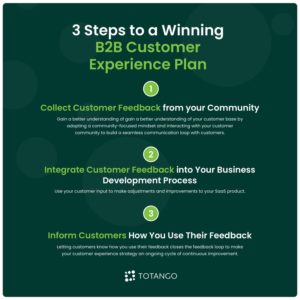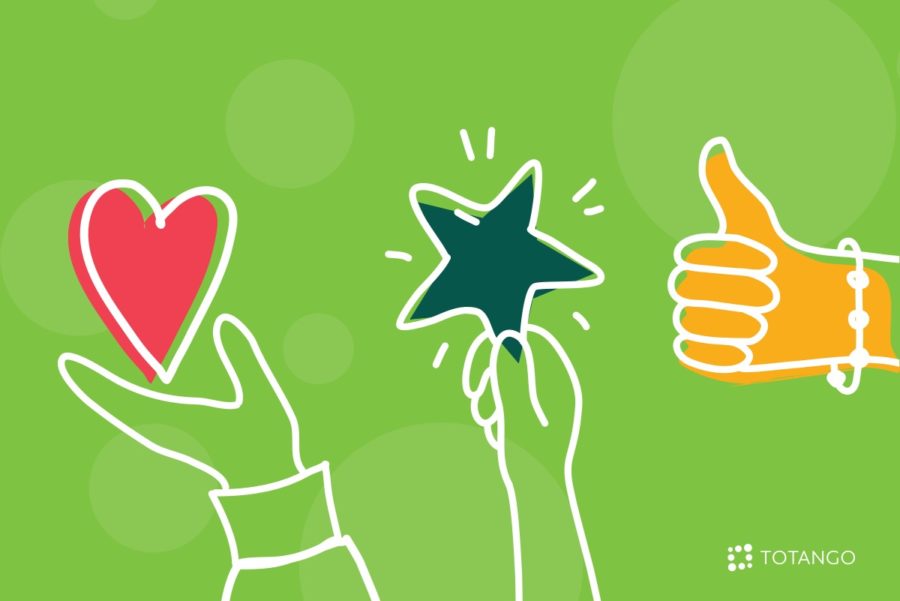Delivering a satisfying B2B customer experience is key to staying competitive in today’s SaaS market. Here, we’ll outline a strategic roadmap to developing a winning B2B customer experience strategy. First, we’ll take a look at what B2B customer experience is and why it’s an important priority. Then, we’ll walk you through three steps for creating a solid customer experience strategy. Finally, we’ll show you how to ensure the success of your strategy by incorporating customer feedback into your upgrades.
What is B2B Customer Experience?
B2B customer experience consists of the total set of thoughts, emotions, and behaviors that B2B clients undergo when interacting with your brand. This encompasses interactions with your brand during all stages of their customer journey, including before purchase, during the buying process, and after making a purchase.
B2B customer experience differs from B2C customer experience in several important ways. Relationships with B2B customers tend to be more challenging to manage successfully due to complex requirements, a greater number of stakeholders, and organizational interdependencies. In many cases, a small number of B2B clients account for a large percentage of a company’s revenue, leading to a need for multiple engagement models for effective relationship management. Because of these factors, B2B sales and renewal cycles may be longer than their B2C counterparts.
In today’s digital environment, B2B customer experience is driven by online and mobile interactions with brands. Today’s B2B customer researches, purchases and engages with products online. Technology research firm Gartner projects that by 2025, 80% of B2B interactions between suppliers and buyers will be digital.
Why Take B2B Customer Experience Seriously?
Customer experience has a significant impact on customer retention rates as has been shown by several studies conducted on B2C relationships. Nearly three-fourths of all B2C customers factor in experience when making purchasing decisions, according to a report by professional services firm PricewaterhouseCoopers. Just one bad experience will drive 17% of customers away, while several bad experiences will cause 59% to walk away from a brand. In contrast, consumers across a range of industries say they would pay 7% to 16% more for products from brands that deliver a great customer experience.
Despite this data on the importance of B2C customer experience, B2B brands have lagged in prioritizing their clients’ experiences. Just 14% of large B2B brands are truly customer-centric, according to research by market research firm B2B International.
B2B companies that aren’t prioritizing customer experience are missing out on the competitive edge enjoyed by their B2C counterparts. For example, Amazon, which has the highest customer satisfaction rating in its industry as measured by Net Promoter Score, generates a third of its revenue from cross-sells, illustrating how a good customer experience can increase spending per customer. In a B2B SaaS context, delivering a frictionless customer experience can improve sign-up rates and free-to-paying customer upgrades for freemium apps.
Three Steps to Create a Flawless B2B Customer Experience Strategy
So, how do you deliver a superior B2B customer experience? Start by developing an effective B2B customer experience strategy using these three simple steps.
1. Collect Customer Feedback from Your Community
Good customer experience depends on listening to your customers. You can gain a better understanding of your customer base by adopting a community-focused mindset and interacting with your customer community to build a seamless communication loop with customers. Go beyond the passive collection of NPS scores by proactively collecting customer feedback via interviews, polls, heatmap software, and other community engagement initiatives.
2. Integrate Customer Feedback into Your Business Development Process
Collecting customer feedback empowers you to incorporate it into your business development processes. Use your customer input to make adjustments and improvements to your SaaS product. This improves the quality of their experience while giving them more sense of ownership over their toolset and more investment in your product development. Seek feedback from customers at key junctures in the relationship, after meaningful interactions, or when certain milestones are hit for better responses rates and more actionable insights.
3. Inform Customers How You Use Their Feedback
Letting customers know how you use their feedback closes the feedback loop to make your customer experience strategy an ongoing cycle of continuous improvement. For example, when you make product updates, announce how you’ve incorporated customer feedback into improving your product, and send personalized messages to customers who requested particular features so they’re aware of their contribution. You can do this by using tools like automated alerts, ticketing systems, and other workflows. Utilize the collaborative nature of the myriad of tools available to customer experience managers today to engage and empower customers.
Focus on Product Pillars to Incorporate Feedback and Updates
When collecting feedback and planning updates, you can gain the most leverage to make improvements by focusing on four fundamental product pillars: Features, user interface and user experience, performance, and support. Concentrate on these essentials to maximize the impact of your customer experience strategy.
Features
Your features define your product and set it apart from the competition. Make sure that your product includes the features your customers say they want most in their feedback. Study the features offered by your competitors to make sure you’re providing the most feature-rich product in your niche.
User Interface and User Experience
Your UI and UX set the tone for customers’ daily interactions with your product. Make sure that you’re providing a user-friendly, engaging experience. Use customer feedback to optimize your UI and UX by making changes your customers request and removing any barriers to an enjoyable experience.
Performance
Ultimately, performance is the test of your product. Use customer feedback to make sure your product is delivering what your customers want. Your product should be user-friendly, fast, and hassle-free.
Support
Support can be as important for customer experience as your product itself. If a customer is already having problems with your product, a bad support experience can multiply their irritation. Pay attention to customer support tickets and identify any frequent customer service issues that need to be addressed.
Deliver Satisfying B2B Customer Experience to Increase Customer Retention
B2B customer experience is defined by the thoughts, emotions, and behaviors customers engage in when interacting with your brand. B2B customer experience tends to be more complex and personalized than B2C experience, with a longer sales cycle. In a SaaS context, B2B customer experience is centered around digital interactions.
 Improving B2B customer experience can increase customer retention and give you an edge over competitors who aren’t prioritizing improvements in this area. You can develop a customer experience strategy by collecting customer feedback, incorporating it into upgrades, and letting customers know what you do with their input. When inviting feedback and developing upgrades, focus on improving features, user interface, experience, performance, and support.
Improving B2B customer experience can increase customer retention and give you an edge over competitors who aren’t prioritizing improvements in this area. You can develop a customer experience strategy by collecting customer feedback, incorporating it into upgrades, and letting customers know what you do with their input. When inviting feedback and developing upgrades, focus on improving features, user interface, experience, performance, and support.
The central role digital experience plays in SaaS customer interactions makes the right technology critical for the effective implementation of your customer experience strategy. Totango’s customer success platform is designed to help you deliver an optimal customer experience throughout your customer lifecycle by monitoring key customer data and triggering automated best practices consistent with satisfying customer outcomes. Try it free to see how customer success technology can help you deliver better experiences that increase client retention.

